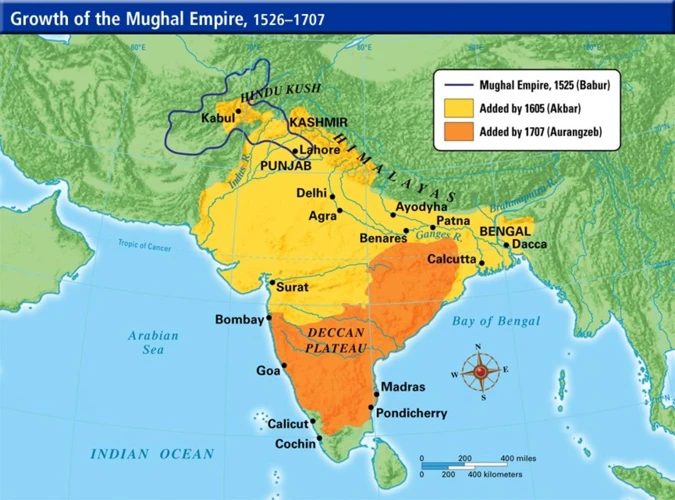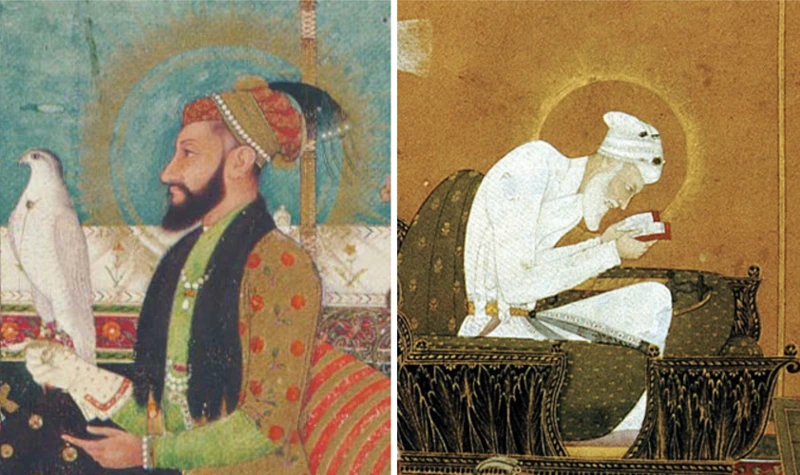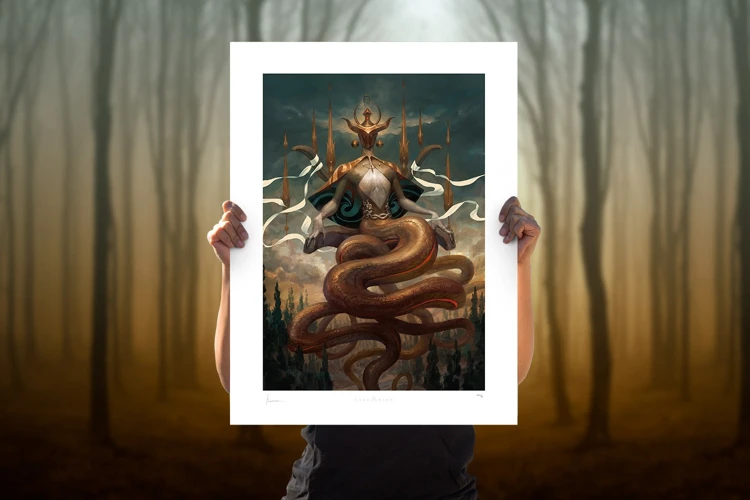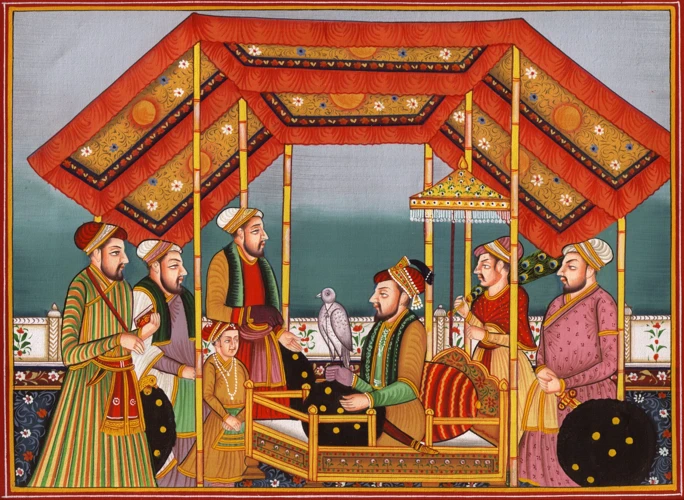When one thinks of India, its rich history and vibrant culture often come to mind. Among the many empires that have left their mark on the subcontinent, the Mogul Empire stands out as a shining example of India’s golden age of art and architecture. From the 16th to the 19th centuries, this powerful dynasty established its rule, leaving behind a legacy that still captivates the world today. The Mogul Empire was known for its grandeur, opulence, and fusion of Persian and Indian influences. This article will take you on a journey through the rise of the Mogul Empire, its artistic achievements, famous monuments and artworks, and its lasting impact on Indian culture and heritage. Get ready to be dazzled by the splendor of the Mogul Empire’s golden age.
Contents
- The Rise of the Mogul Empire
- Artistic Achievements of the Mogul Empire
- Famous Monuments and Artworks
- The Legacy of the Mogul Empire
- Conclusion
-
Frequently Asked Questions
- 1. What was the significance of the Mogul Empire in Indian history?
- 2. Who were some of the prominent rulers of the Mogul Empire?
- 3. How did the Mogul Empire impact the cultural landscape of India?
- 4. What architectural styles were prevalent during the Mogul Empire?
- 5. What was the significance of Akbar the Great’s reign?
- 6. What were some of the major administrative reforms instituted by Akbar?
- 7. What is the significance of the Taj Mahal in the context of the Mogul Empire?
- 8. How did the decline of the Mogul Empire come about?
- 9. What impact did the Mogul Empire have on modern Indian art and architecture?
- 10. How can we appreciate and preserve the legacy of the Mogul Empire?
- References
-
Frequently Asked Questions
- FAQs about the Mogul Empire: India’s Golden Age of Art and Architecture
- 1. What was the significance of the Mogul Empire in Indian history?
- 2. How did the Mogul Empire come into existence?
- 3. Who was Akbar the Great and why was he important?
- 4. What were the main influences on Mogul art?
- 5. What were the key features of Mogul architecture?
- 6. What is the significance of the Taj Mahal?
- 7. Why is the Red Fort important?
- 8. What is unique about Humayun’s Tomb?
- 9. How did the Mogul Empire influence Indian culture and heritage?
- 10. How does the legacy of the Mogul Empire influence modern Indian art and architecture?
- References
- Read More
The Rise of the Mogul Empire

The Mogul Empire, also known as the Mughal Empire, traces its origins back to 1526 when Babur, a descendant of both Genghis Khan and Tamerlane, established his rule in northern India. This marked the beginning of the empire’s reign and the foundation of a dynasty that would shape the course of Indian history. Babur’s conquests were not without challenges. He faced fierce resistance from the existing powers and had to employ diplomatic strategies to solidify his rule. His successors, however, proved to be even more formidable. Akbar the Great, Babur’s grandson, ascended to the throne in 1556 and ushered in an era of expansion, consolidation, and cultural renaissance. Under Akbar’s rule, the empire reached its zenith, encompassing most of the Indian subcontinent. His reign was marked by significant administrative reforms, religious tolerance, and a policy of inclusive governance. The Mogul Empire’s rise to power was not only characterized by military conquests but also by diplomatic alliances and strategic marriages. Akbar married Rajput princesses to foster alliances with the Hindu ruling elites and promote religious harmony. This approach not only strengthened the empire but also laid the foundation for the syncretic culture that would define the Mogul Empire. The rise of the Mogul Empire was a culmination of ambition, military prowess, diplomacy, and the ability to assimilate diverse cultures, setting the stage for a golden age of art and architecture that would leave an indelible mark on Indian history.
1. Establishing the Empire
Establishing the Mogul Empire was no easy feat, as it required strategic military campaigns and political maneuvering. After Babur’s initial victories in India, he faced numerous challenges in solidifying his rule. He strategically formed alliances with local Rajput rulers, making use of their knowledge of the local terrain and their military capabilities. Babur’s military tactics were innovative and unconventional, using artillery and firearms to gain an advantage over his opponents. One of his most significant victories came in 1527 at the Battle of Khanwa, where he defeated the Rajput confederacy led by Rana Sanga. This victory ensured his control over the northern region of India. Babur’s establishment of the empire was not limited to military successes. He also focused on building an effective administrative system. He appointed capable governors to oversee regions and implemented policies aimed at creating stability and prosperity. This included encouraging trade and commerce, promoting agriculture, and protecting the rights of his subjects. Babur’s visionary approach laid the foundation for the Mogul Empire, providing the framework for future rulers to expand their territories and build upon his legacy.
2. The Reign of Akbar the Great
Akbar the Great, the third ruler of the Mogul Empire, reigned from 1556 to 1605 and is widely regarded as one of the most influential and visionary emperors in Indian history. Akbar’s reign was characterized by a series of notable accomplishments and innovations that left a lasting impact on the empire’s administration, culture, and society. One of Akbar’s key achievements was his policy of religious tolerance and inclusivity, which aimed to bridge the gap between different religious communities within his realm. He abolished the discriminatory taxes imposed on non-Muslims and actively sought to understand and appreciate diverse religious beliefs. This approach not only promoted harmony among his subjects but also allowed for the assimilation of different cultural and artistic traditions, leading to the development of a unique syncretic culture. Akbar was also a patron of the arts and sciences and established a vibrant court where poets, musicians, painters, and scholars thrived. He encouraged the translation of ancient texts and the creation of new literary works, resulting in a flowering of Persian, Urdu, and Hindi literature. Akbar’s quest for knowledge extended to the realms of philosophy, astrology, and mysticism. He welcomed scholars from various disciplines and engaged in intellectual debates, leading to the formation of the renowned “Nine Gems” or “Navaratnas” at his court. The reign of Akbar the Great marked a period of extraordinary intellectual and cultural vibrancy in the Mogul Empire, setting the stage for the flourishing of art and architecture that would become the empire’s hallmark. Whether through his policies of religious tolerance, support for the arts, or intellectual pursuits, Akbar’s reign ecompassed a bold and unparalleled vision for the empire’s progress and prosperity.
Artistic Achievements of the Mogul Empire

The artistic achievements of the Mogul Empire were nothing short of magnificent, blending the rich traditions of Persian and Indian art to create a unique and awe-inspiring aesthetic. The empire’s ruling elite, especially the emperors themselves, patronized a flourishing artistic culture that encompassed various mediums such as painting, architecture, textiles, and jewelry. Persian influences played a significant role in shaping Mogul art. The empire’s emperors, including Akbar, Jahangir, and Shah Jahan, commissioned exquisite miniature paintings that depicted scenes from court life, epic poems, and religious stories. These miniatures showcased a distinct blending of Persian and Indian artistic styles, with intricate detailing, vibrant colors, and a delicate portrayal of human forms. The Mogul Empire also left behind a remarkable architectural legacy. The most iconic example is the Taj Mahal, a mausoleum built by Shah Jahan in memory of his beloved wife, Mumtaz Mahal. With its symmetrical layout, intricate marble inlay work, and stunning domed structure, the Taj Mahal stands as a testament to the empire’s architectural brilliance. Other architectural marvels include the Red Fort in Delhi, known for its imposing red sandstone walls and intricate carvings, and Humayun’s Tomb, which served as a prototype for future grandiose Mughal mausoleums. These artistic achievements of the Mogul Empire continue to inspire and captivate people from around the world, showcasing the empire’s golden age and its lasting impact on the world of art and architecture.
1. The Influence of Persian and Indian Art
The art of the Mogul Empire was deeply influenced by the fusion of Persian and Indian artistic traditions. This amalgamation resulted in a unique and exquisite style that became synonymous with the empire’s cultural identity. Persian art brought with it elements of intricate geometric patterns, delicate calligraphy, and the use of vibrant colors. Indian art, on the other hand, contributed elements such as intricate details, storytelling motifs, and a rich variety of materials. The amalgamation of these two influences gave rise to a new art form that showcased the splendor and grandeur of the Mogul Empire.
One of the most prominent examples of this influence is seen in the Mogul miniature paintings. These miniature paintings borrowed techniques and themes from both Persian and Indian art. They typically depicted scenes from courtly life, religious narratives, and portraits of the emperors and their royal court. The paintings showcased meticulous detailing, vibrant colors, and a harmony between Persian-style landscapes and Indian-style characters.
Another significant aspect of the influence of Persian and Indian art on the Mogul Empire was evident in the architecture. The empire’s architectural marvels, such as the palaces, forts, and tombs, incorporated elements from both Persian and Indian architectural styles. The grandeur and scale of Persian architecture were combined with the intricacy and ornamentation of Indian architecture.
The influence of Persian and Indian art extended beyond visual forms and encompassed other artistic expressions as well. Literature, music, and dance flourished under the patronage of the Mogul emperors. Persian poetry and literature, particularly the works of renowned poets such as Amir Khusrau, found a significant place within the empire’s cultural fabric.
The fusion of Persian and Indian art was instrumental in shaping the artistic achievements of the Mogul Empire. This amalgamation resulted in a unique and mesmerizing artistic style that exemplified the grandeur, beauty, and cultural richness of the empire. The influence of Persian and Indian art can be seen in the miniature paintings, architecture, literature, and various other forms of artistic expressions that flourished during the empire’s golden age.
2. The Splendor of Mogul Architecture
The splendor of Mogul architecture is a testament to the empire’s grandeur and artistic prowess. Mogul architects blended elements of Persian, Indian, and Islamic styles to create breathtaking structures that continue to awe visitors to this day. One of the most iconic examples of Mogul architecture is the Taj Mahal, a mausoleum commissioned by Emperor Shah Jahan in memory of his beloved wife, Mumtaz Mahal. This architectural masterpiece is renowned for its symmetrical design, intricate marble inlays, and the shimmering white dome that seems to touch the heavens. The Red Fort in Delhi is another remarkable structure, serving as the residence and administrative center for the emperors. Its imposing walls, intricate carvings, and sprawling gardens reflect the opulence of the Mogul Empire. Humayun’s Tomb, a UNESCO World Heritage Site, showcases the fusion of Persian and Indian architectural styles with its symmetrical layout, intricate tile work, and beautiful gardens. Mogul architecture also encompassed other forms of buildings such as palaces, mosques, and tombs, each displaying exquisite craftsmanship and attention to detail. The extensive use of red sandstone and marble, intricate floral and geometric patterns, and the incorporation of calligraphy all contributed to the magnificence of Mogul architecture. These architectural marvels not only served as symbols of the empire’s power and wealth but also as lasting legacies of its artistic achievements. The splendor of Mogul architecture continues to inspire awe and admiration and stands as a testament to the empire’s golden age.
Famous Monuments and Artworks

The Mogul Empire left behind a treasure trove of magnificent monuments and artworks that serve as a testament to its grandeur and artistic legacy. One of the most iconic masterpieces of the empire is the Taj Mahal, a mausoleum commissioned by Emperor Shah Jahan in memory of his beloved wife Mumtaz Mahal. This architectural marvel is renowned for its intricate marble carvings, delicate inlay work, and symmetrical design. Another notable monument is the Red Fort in Delhi, a sprawling complex that served as the residence of the emperor and the seat of power for the empire. The fort boasts impressive structures like the Diwan-i-Aam (Hall of Public Audience) and the Diwan-i-Khas (Hall of Private Audience), which showcase the empire’s architectural finesse. Furthermore, Humayun’s Tomb in Delhi, built in the 16th century, is an architectural masterpiece and served as a prototype for later Mughal mausoleums, including the Taj Mahal. These magnificent monuments, with their intricate detailing, exquisite craftsmanship, and elegant designs, stand as a testament to the artistic achievements of the Mogul Empire. They continue to captivate visitors from around the world, offering a glimpse into the opulence and splendor of India’s golden age of art and architecture.
1. Taj Mahal
The Taj Mahal, an iconic masterpiece of Mogul architecture, stands as a testament to the opulence and grandeur of the Mogul Empire. Commissioned by Emperor Shah Jahan in the 17th century as a mausoleum for his beloved wife Mumtaz Mahal, it took over 20,000 workers and 22 years to complete. The Taj Mahal is renowned for its exquisite craftsmanship and delicate inlay work. The main structure is constructed entirely of white marble, gleaming magnificently under the sunlight. The domed mausoleum is surrounded by four minarets, symbolizing the four corners of the world. The intricate floral patterns and calligraphy adorning the walls and gateways are mesmerizing, showing the mastery of the artisans who contributed to its construction. The Taj Mahal is a harmonious blend of Islamic, Persian, and Indian architectural styles, creating a sublime fusion that represents the cultural synthesis of the Mogul Empire. Its beauty and significance have earned it a place as one of the New Seven Wonders of the World, attracting millions of visitors each year who marvel at its breathtaking splendor. To truly understand the magnificence of the Taj Mahal, one must see it in person and experience the ethereal ambiance that surrounds this architectural marvel.
2. Red Fort
The Red Fort, also known as Lal Qila, is an iconic monument and a testament to the architectural marvels of the Mogul Empire. Constructed during the reign of Emperor Shah Jahan, the Red Fort stands proudly in the heart of Old Delhi, India. This magnificent fort was completed in 1648 and served as the main residence of the Mogul emperors for nearly 200 years. It got its name from the red sandstone used in its construction, which gives it a striking appearance. The Red Fort is a masterpiece of Mogul architecture, showcasing a blend of Persian, Indian, and European influences. The fort complex is spread over a vast area and is enclosed within high walls that span approximately 2.5 kilometers. As one enters through the imposing Lahore Gate, they are greeted by the Chatta Chowk, a bustling market where merchants once sold their wares. Moving ahead, visitors can marvel at the Diwan-i-Aam, or the Hall of Public Audience, where the emperor would address and meet with his subjects. The Diwan-i-Khas, or the Hall of Private Audience, is another architectural gem within the fort, adorned with intricate marble carvings and a stunning central marble pillar. The fort also houses the stunning Rang Mahal, or Palace of Colors, which once served as the residence of the royal women. Additionally, the fort is home to the magnificent Pearl Mosque, or Moti Masjid, which is a testament to the Mogul Empire’s devotion to Islamic art and architecture. The Red Fort is not just a symbol of architectural prowess but also a witness to significant historical events, including the Indian Independence Day celebrations that take place annually on its grounds. Today, the Red Fort stands as a UNESCO World Heritage Site, attracting visitors from around the world who are fascinated by its opulence and grandeur. Exploring the Red Fort is like stepping back in time and experiencing the grand lifestyle of the Mogul emperors. It is truly a must-visit destination for anyone seeking to immerse themselves in the rich history and architectural wonders of the Mogul Empire.
3. Humayun’s Tomb
Humayun’s Tomb, located in Delhi, is one of the most remarkable architectural achievements of the Mogul Empire. Built in the mid-16th century, the tomb is a magnificent testament to the grandeur and artistry of the era. Commissioned by Bega Begum, the widow of Emperor Humayun, the tomb is not only a mausoleum but also a beautiful garden complex. Its design is credited to the Persian architect Mirak Mirza Ghiyas, who incorporated elements of Persian and Indian architectural styles to create a unique masterpiece. The tomb itself is a three-story structure with a central octagonal chamber that houses the marble sarcophagus of Humayun. The exterior of the tomb is adorned with intricate geometric patterns and delicate calligraphy, showcasing the skilled craftsmanship of the Mogul artisans. Surrounding the tomb is a Charbagh garden, divided into four quadrants by water channels symbolizing the four rivers of Paradise described in the Quran. The garden is meticulously landscaped with lush greenery, flowering plants, and symmetrical pathways, creating a tranquil and serene atmosphere. Humayun’s Tomb served as a precursor to the iconic Taj Mahal, with its architectural elements inspiring future Mogul tombs and structures. Today, the tomb is a UNESCO World Heritage site and a popular tourist attraction, drawing visitors from around the world to admire its architectural splendor and pay homage to the emperor who rests within its grand walls.
The Legacy of the Mogul Empire

The legacy of the Mogul Empire is profound and far-reaching, shaping not only Indian culture and heritage but also leaving a lasting influence on modern Indian art and architecture. The empire’s impact on Indian society can still be felt today, as many of its traditions and customs continue to thrive. One of the most significant contributions of the Mogul Empire is the fusion of Persian and Indian influences in various art forms. This amalgamation created a unique aesthetic that blended intricate Persian motifs with the elegance and vibrancy of Indian art. The empire’s rich architectural heritage is also a testament to its enduring legacy. Monuments such as the Taj Mahal, the Red Fort, and Humayun’s Tomb are iconic symbols of the Mogul Empire’s grandeur and splendor. These magnificent structures showcase the empire’s architectural prowess and reflect the fusion of different architectural styles, including Persian, Islamic, and Indian elements. The Mogul Empire’s artistic and architectural achievements continue to inspire contemporary artists and architects in India. Many modern structures draw inspiration from the empire’s distinctive artistic style, paying homage to its enduring legacy. Through its artistic and architectural heritage, the Mogul Empire has left an indelible mark on India’s cultural fabric, enriching the nation’s identity and acting as a bridge between the past and the present. Truly, the Mogul Empire’s legacy resonates through the ages as a testament to the power of art and the enduring nature of cultural heritage. Ophiuchus zodiac personality
1. Impact on Indian Culture and Heritage
The Mogul Empire had a profound impact on Indian culture and heritage, leaving behind a rich and enduring legacy. One of the most significant contributions was in the field of art and literature. The court of the Mogul emperors became a vibrant center for creativity, attracting poets, painters, and scholars from all over the empire. This patronage of the arts resulted in the development of a distinct Mogul style that blended Persian and Indian influences. Miniature paintings flourished during this period, depicting scenes from court life, epic stories, and religious themes. The Moguls also had a deep appreciation for literature, with the emperor Akbar setting up a royal workshop to translate Sanskrit texts into Persian. This endeavor not only promoted the exchange of ideas but also helped preserve invaluable Indian literary works. The Mogul Empire’s impact on Indian culture extended beyond the arts. The empire’s policy of religious tolerance allowed different faiths to flourish side by side, leading to the growth of syncretic practices and the development of a composite culture. This cultural fusion can be seen in the architecture, language, music, and cuisine of India even today. The Mogul rulers’ fascination with Indian traditions and their efforts to integrate with the local populace ensured that the empire became an integral part of India’s cultural tapestry. The empire’s impact on Indian culture and heritage cannot be overstated, as it forever changed the artistic, literary, and social landscape of the subcontinent.
2. Influence on Modern Indian Art and Architecture
The influence of the Mogul Empire on modern Indian art and architecture is undeniable. The architectural marvels that were built during this golden age continue to inspire and shape the landscape of India today. The Mogul style of architecture, characterized by its grandeur, intricacy, and fusion of Persian and Indian elements, has left a lasting imprint on the country’s architectural heritage. The most iconic example of Mogul architecture is the magnificent Taj Mahal, a mausoleum built by Emperor Shah Jahan in memory of his beloved wife Mumtaz Mahal. This timeless masterpiece showcases the impeccable craftsmanship, intricate marble inlay work, and symmetrical design that define Mogul architecture. The Taj Mahal’s influence can be seen in numerous modern structures across India, with architects drawing inspiration from its elegant domes, arches, and delicate ornamentation. Another notable Mogul architectural masterpiece is the Red Fort in Delhi, a sprawling fortress complex that served as the residence of the Mogul emperors. Its imposing walls, intricate carvings, and decorative motifs continue to captivate visitors to this day. Mogul influences can also be observed in modern Indian paintings, with artists drawing inspiration from the vibrant color palettes, meticulous detailing, and storytelling elements found in Mogul miniature paintings. The Mogul Empire’s influence on modern Indian art and architecture has not only shaped the visual landscape of the country but also serves as a testament to the timeless beauty and artistic achievement of this golden age.
Conclusion

In conclusion, the Mogul Empire stands as a testament to the grandeur and cultural brilliance of ancient India. Through its rise, the empire brought about a period of remarkable artistic achievements and architectural marvels. The fusion of Persian and Indian artistry created a unique and captivating aesthetic that continues to inspire and awe. The magnificent monuments and artworks produced during this time, such as the iconic Taj Mahal, the majestic Red Fort, and the breathtaking Humayun’s Tomb, are not only architectural wonders but also symbols of love, power, and artistic prowess. The legacy of the Mogul Empire extends beyond its physical creations. It left an indelible impact on Indian culture and heritage, influencing traditions, language, and social customs. Even today, modern Indian art and architecture bear the imprint of the Mogul Empire’s artistic style and influences. This golden age of art and architecture remains an enduring source of inspiration and pride for India. The Mogul Empire’s reign marked a time of cultural blossoming and creative excellence, leaving behind a lasting legacy that continues to enchant and fascinate the world.
Frequently Asked Questions

1. What was the significance of the Mogul Empire in Indian history?
The Mogul Empire played a crucial role in Indian history as it brought about a period of political stability, cultural assimilation, and artistic brilliance. It left a lasting legacy in terms of architecture, art, and governance.
2. Who were some of the prominent rulers of the Mogul Empire?
Some of the notable rulers of the Mogul Empire include Babur, Akbar the Great, Jahangir, Shah Jahan, and Aurangzeb. Each ruler contributed to the empire’s growth and had their own unique contributions.
3. How did the Mogul Empire impact the cultural landscape of India?
The Mogul Empire played a pivotal role in creating a fusion of Persian and Indian cultures. This blend influenced various aspects of Indian culture, including art, architecture, language, cuisine, and clothing.
4. What architectural styles were prevalent during the Mogul Empire?
The Mogul Empire was known for its distinctive architectural style that blended elements of Persian, Islamic, and Indian architecture. It is characterized by grandeur, meticulous ornamentation, and the extensive use of marble and intricate carvings.
5. What was the significance of Akbar the Great’s reign?
Akbar the Great is considered one of the most notable rulers of the Mogul Empire. His reign was marked by religious tolerance, administrative reforms, artistic patronage, and the promotion of cultural assimilation, which greatly influenced the empire’s trajectory.
6. What were some of the major administrative reforms instituted by Akbar?
Akbar introduced several administrative reforms, such as the establishment of a centralized system of governance, a uniform revenue system, and the integration of diverse cultures and religions into the empire.
7. What is the significance of the Taj Mahal in the context of the Mogul Empire?
The Taj Mahal is a monumental mausoleum built by Emperor Shah Jahan in memory of his wife, Mumtaz Mahal. It is considered a crown jewel of Mogul architecture and is an enduring symbol of love, beauty, and the artistic achievements of the empire.
8. How did the decline of the Mogul Empire come about?
The decline of the Mogul Empire can be attributed to a combination of factors, including invasions by external forces, internal conflicts, economic mismanagement, and a loss of central authority and control.
9. What impact did the Mogul Empire have on modern Indian art and architecture?
The artistic and architectural styles developed during the Mogul Empire continue to influence modern Indian art and architecture. Many of the techniques and design elements employed during that era are still prevalent in contemporary Indian art forms.
10. How can we appreciate and preserve the legacy of the Mogul Empire?
Preserving the legacy of the Mogul Empire involves the conservation and restoration of its architectural masterpieces, promoting awareness and understanding of the empire’s cultural contributions, and studying and celebrating its artistic achievements.
References
- The Art of Cloth in Mughal India
- Mughal Empire contribution to Islamic art and architecture …
- Mughal Empire
Frequently Asked Questions

FAQs about the Mogul Empire: India’s Golden Age of Art and Architecture
Here are some frequently asked questions about the Mogul Empire and its artistic achievements:
1. What was the significance of the Mogul Empire in Indian history?
The Mogul Empire was a powerful empire that ruled over India from the 16th to the 19th century. It left a lasting impact on Indian history by promoting cultural exchange, religious tolerance, and the flourishing of art and architecture.
2. How did the Mogul Empire come into existence?
The Mogul Empire was established by Emperor Babur, a descendant of Genghis Khan and Timur. Babur invaded India, defeated the Delhi Sultanate, and laid the foundation of the Mogul Empire in 1526.
3. Who was Akbar the Great and why was he important?
Akbar the Great was one of the most famous Mogul emperors who ruled from 1556 to 1605. He was known for his administrative skills, promotion of religious tolerance, and patronage of the arts, which led to a golden age of cultural development in the empire.
4. What were the main influences on Mogul art?
Mogul art was influenced by a combination of Persian and Indian artistic traditions. Persian art introduced techniques such as intricate miniature paintings and the use of precious stones, while Indian art contributed elements of vibrant colors, intricate carvings, and architectural styles.
5. What were the key features of Mogul architecture?
Mogul architecture is characterized by its grandeur, symmetry, and intricate ornamentation. It incorporates elements such as large domes, minarets, arches, and extensive use of marble and red sandstone.
6. What is the significance of the Taj Mahal?
The Taj Mahal is one of the most famous Mogul monuments and is considered a masterpiece of Mogul architecture. It was built by Emperor Shah Jahan as a mausoleum for his beloved wife, Mumtaz Mahal. The Taj Mahal is renowned for its exquisite marble inlay work and its breathtaking beauty.
7. Why is the Red Fort important?
The Red Fort, located in Delhi, served as the residence of the Mogul emperors. It is a prime example of Mogul architecture and a symbol of their power and grandeur. The Red Fort is now a UNESCO World Heritage site and a popular tourist attraction.
8. What is unique about Humayun’s Tomb?
Humayun’s Tomb is an impressive Mogul mausoleum and is considered a precursor to the architectural style of the Taj Mahal. It features a combination of Persian and Indian architectural elements, including a grand dome and extensive use of red sandstone.
9. How did the Mogul Empire influence Indian culture and heritage?
The Mogul Empire played a significant role in shaping Indian culture and heritage. It fostered a rich artistic legacy, promoted cultural exchange, and saw the development of a distinct Indo-Persian art and architectural style. It also influenced the traditions and customs of the Indian people.
10. How does the legacy of the Mogul Empire influence modern Indian art and architecture?
The artistic achievements of the Mogul Empire continue to inspire contemporary Indian artists and architects. The fusion of Persian and Indian artistic styles, as seen in Mogul art and architecture, is often reimagined in modern designs, showcasing a seamless blend of tradition and innovation.






